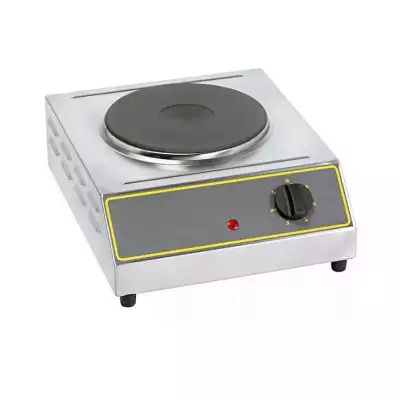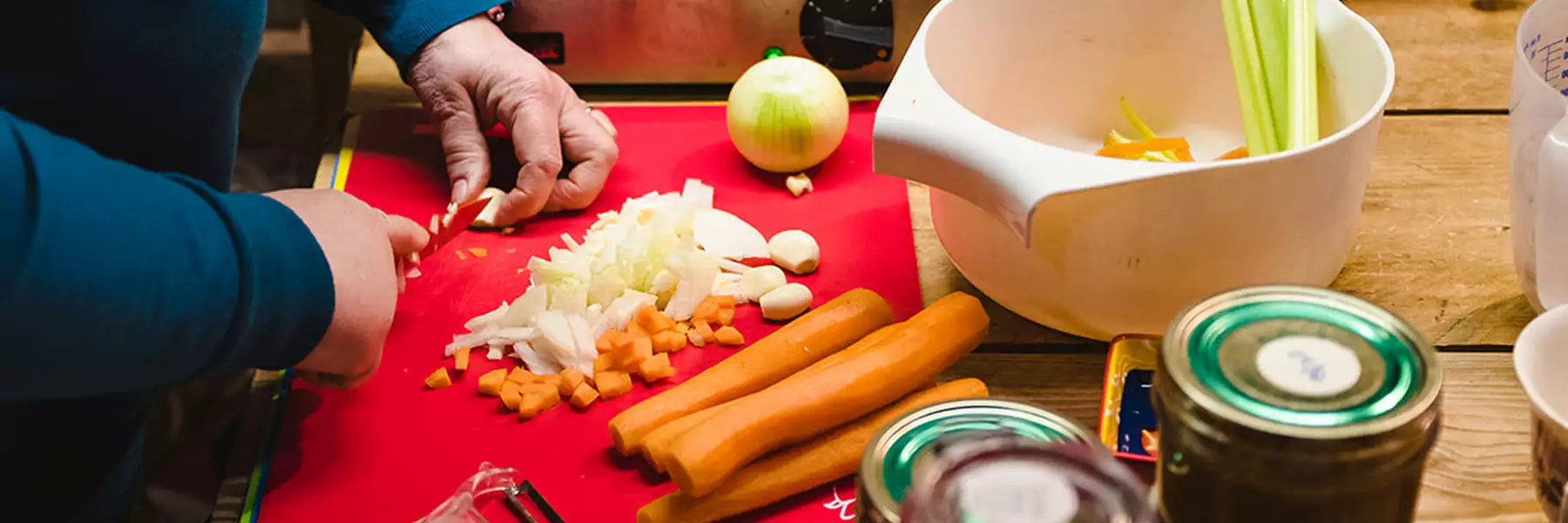
The Why, Who, What, When & Where of Pressure Canning
WHY
The preservation of food at home has never been as important as it is now for maybe 70-100 years.
We are used to freezing, jam and preserve making, water bath canning - even dehydrating. Not everyone does these things but most have heard of them. There is a relative newcomer on the scene in the UK and that newcomer is Pressure Canning. This is a mature process in US but until the last few years we have stopped short at the water bath canning or bottling stage.
Whether you want an alternative to freezing for you own home-grown produce, or you love to shop for bargains at the store, to forage for food or to make your own-cooked meals as a convenience for when you don’t have time to cook, then pressure canning can prove to be invaluable.
What is the difference between them though? Well, water bath or bottling involves the same kind of jars - those with a two-part seal usually, or a glass lid with a rubber seal that clips down tightly, but this process isn’t suitable for low acid foods including meat based preserves.
Pressure Canning, as it’s name suggests, involves increasing the temperature of the contents of the canner above that achievable by bottling in a water bath. Increasing the temperature by the use of pressure ensures that bacteria are killed, along with the yeasts and molds that will spoil your food. The main bacteria to be aware of is Clostridium botulinum or Botulism. At best, this is extremely unpleasant, but for many it would prove fatal.
So rules must be followed and care taken.
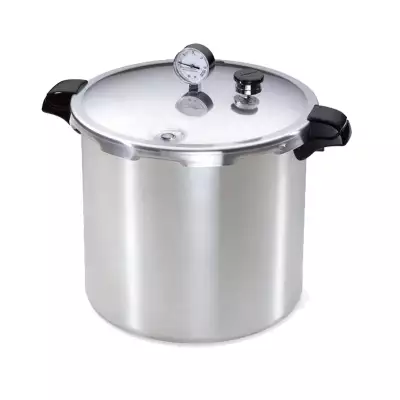
Presto 23 Quart Canner
WHY
Before you get into preserving in a big way - and certainly before you invest in a pressure canner you need to ask the most important question.
Who are you preserving for?
Evaluating who you intend to preserve food for is essential before you embark on buying your jars and other equipment, and deciding on the size of pressure canner that you need - or whether you need one at all.
For instance the size of jar you will need is very different if you are preparing food or meals for one or two people or a larger family. For the former, the 500ml jars will be sufficient in the main, but for the latter it will depend on the way that your family actually eat their food.
Do you all eat together? If this is the case then several portions can be processed into larger jars that will feed you all at one sitting.
Do you all eat the same thing? You, or other member(s) of your family may be vegetarian or vegan, or have some other dietary needs, in which case it would be helpful to split meals into smaller portions and buy jars accordingly. Large batches of appropriate food could then be prepared but still processed in single portion jars. Special diets can then easily be catered for without resorting to commercial processed foods and ‘quick fixes’.
Do you need to cater for extended family and friends? In which case, the above applies, together with getting your precious canning jars returned. No return = no replacements.
WHAT
So now you know WHO, what will you need to achieve this and what will you be preserving?
Well first up - you are going to need a pressure canner. We stock the Presto 23 Quart model because it has been widely used in US over many, many years and there isn’t really anything that can go drastically wrong with it. Essentially a large, aluminium empty vessel with valves and a gauge so that the unit can be pressurised and so raise the temperature that your preserves are subjected to. Please refer to the Pressure Canner section for more detailed advice.
You will need to timer the processing so you will need to do this accurately either by using a timer, or your mobile phone.
You will also need a selection of jars that you have identified in the WHO section. There is more detailed information in the Jar section evaluating the various types available and you can make your decision accordingly.
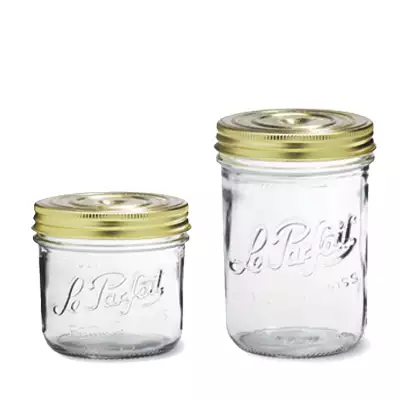
Le Parfait Screw Top Jar
WHEN
You need to make sure, when you are planning to process foods, that you allow yourself plenty of time, especially when you are starting out.
You need time to get organised with everything that you need. Time to read and probably re-read the instructions. Time to supervise the canner while it is underway and time to allow it to cool and de-pressurise before you are able to open it. You really should be there with it as much as possible, especially if there are other people around - you don’t want the heat turned down by a well meaning spouse for instance, believing that the escaping steam is a sign it is heating too high!
Children should be supervised around the canner or, ideally, they shouldn’t be in the vicinity so that you can concentrate. Once the processing is complete you will need to allow sufficient time to lift the jars from the canner and to leave them undisturbed for as much as 24 hours. The screw bands will then need to be removed and the seals checked. Any that haven’t sealed will need to be refrigerated and used as soon as possible.
Having said this, its not as onerous as it sounds! You soon find your own routine that works for you.
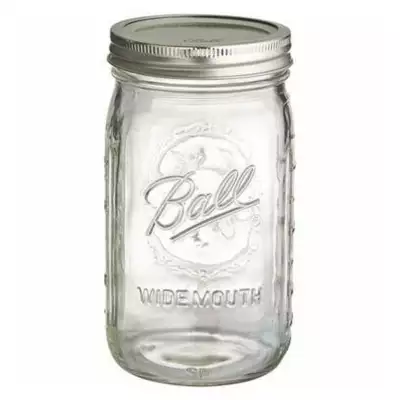
Ball Wide Mouth Jar
WHERE
To some this would be obvious - you no doubt think that you will be using the canner in your kitchen on your hob. You might very well be doing this buy many people these days have induction hobs which don’t work with the standard canner. Induction hob canners are sometimes available but they are more expensive and hard to get hold of.
You might like to consider getting an Induction Ring Adaptor which is a simple plate that fits over the hob plate so that the standard canner can be used (and any other pan that you may have had a problem with of course)
However, I have found that using the canner on my domestic hob makes it very high up and being short, I have a problem manoeuvring it around. I prefer to have a stand alone single plate hob on my kitchen table which makes it a better height for me to work at. Using this approach you could use it in a garage or shed if you wanted to. This would have the added advantage - probably - of you being able to keep all of your jars nearby. In any case, it is as well to have fully thought through what you want to achieve and where you want to keep everything as it can soon overwhelm you if you just ‘start’ (as I well know!)
Once you have processed your food you will also need to store it somewhere ready for use. This needs to be somewhere away from strong light and reasonably cool. The sealed jars need to be labelled clearly - I also keep a log of what I have as it saves keep checking through. The jars need to be on strong shelves on a single layer. This is to prevent any mishaps - if a jar hasn’t sealed properly yeasts and/or moulds and bacteria can build up and the seal can ‘blow’ If it has another jar stacked on top it can be very damaging as the pressure will be that much greater. The jars should also be stored without the screw bands in place ( if used ) for the same reason. If they are left in place it is possible for the jar to shatter from the pressure and then there will be shards of glass as well as rancid food everywhere. Anyone in the vicinity could be badly injured.
As long as you become familiar with the equipment, the process and the few Rules, your pressure canning experience should be trouble free and rewarding.
